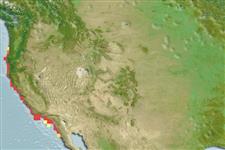>
Ovalentaria/misc (Various families in series Ovalentaria) >
Embiotocidae (Surfperches)
Etymology: Amphistichus: Greek, amphi = on both sides + Greek, stix, -ichos = row (Ref. 45335); koelzi: Named after Walter Koelz, U.S. ichthyologist (Ref. 6885).
More on author: Hubbs.
Environment: milieu / climate zone / depth range / distribution range
Ökologie
seewasser demersal; tiefenbereich 0 - 9 m (Ref. 2850). Subtropical; 49°N - 26°N, 125°W - 112°W
Eastern Pacific: near Cape Flaterry in Washington, USA to northern Baja California, Mexico. Recorded 32 km from the Canadian border (Ref. 6885).
Size / Gewicht / Alter
Maturity: Lm ? range ? - ? cm
Max length : 31.0 cm TL Männchen/unbestimmt; (Ref. 6885)
Rückenflossenstacheln (insgesamt) : 9 - 11; Rückenflossenweichstrahlen (insgesamt) : 24 - 28; Afterflossenstacheln: 3; Afterflossenweichstrahlen: 26 - 32. Generally silvery overlaid with brassy tones; back bluish or olivaceous; lower head and lower anterior part of body tinged with red; sides with series of brown speckles which form rough narrow vertical bars; pectorals plain, other fins usually reddish (Ref. 6885).
Adults occur usually in sand beaches in surf (Ref. 2850). Viviparous, female carries the developing young (Ref. 205).
Life cycle and mating behavior
Maturities | Fortpflanzung | Spawnings | Egg(s) | Fecundities | Larven
Viviparous, female carries the developing young (Ref. 205).
Eschmeyer, W.N., E.S. Herald and H. Hammann, 1983. A field guide to Pacific coast fishes of North America. Boston (MA, USA): Houghton Mifflin Company. xii+336 p. (Ref. 2850)
IUCN Rote Liste Status (Ref. 130435)
Bedrohung für Menschen
Harmless
Nutzung durch Menschen
Fischereien: kommerziell; Sportfisch: ja
Tools
Zusatzinformationen
Download XML
Internet Quellen
Estimates based on models
Preferred temperature (Ref.
123201): 12.2 - 17.8, mean 15.3 °C (based on 49 cells).
Phylogenetic diversity index (Ref.
82804): PD
50 = 0.6250 [Uniqueness, from 0.5 = low to 2.0 = high].
Bayesian length-weight: a=0.01905 (0.00831 - 0.04372), b=2.97 (2.77 - 3.17), in cm total length, based on LWR estimates for this (Sub)family-body shape (Ref.
93245).
Trophic level (Ref.
69278): 3.4 ±0.2 se; based on size and trophs of closest relatives
Widerstandsfähigkeit (Ref.
120179): mittel, Verdopplung der Population dauert 1,4 - 4,4 Jahre. (Assuming tm<5).
Fishing Vulnerability (Ref.
59153): Low vulnerability (21 of 100).
Nutrients (Ref.
124155): Calcium = 99.2 [54.6, 182.5] mg/100g; Iron = 1.05 [0.59, 1.86] mg/100g; Protein = 18.6 [17.6, 19.7] %; Omega3 = 0.226 [0.132, 0.386] g/100g; Selenium = 15.9 [7.3, 33.7] μg/100g; VitaminA = 12 [3, 41] μg/100g; Zinc = 0.792 [0.546, 1.208] mg/100g (wet weight);
